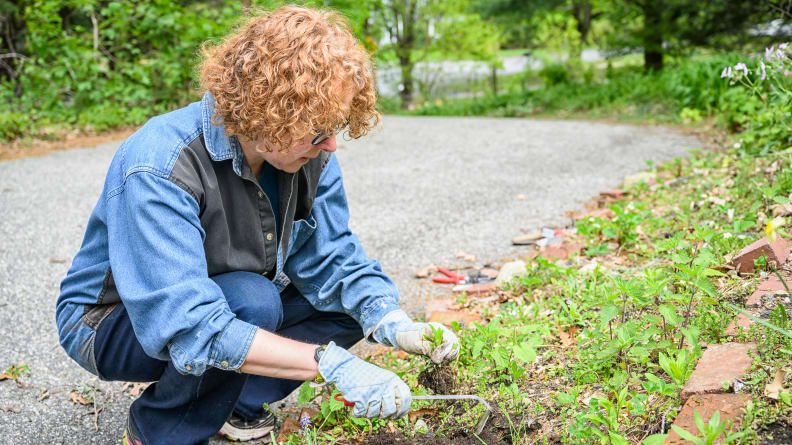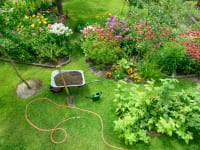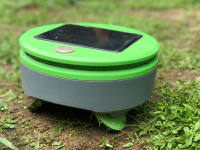How to grow plants even if you know nothing about gardening
Even you can develop a green thumb
Products are chosen independently by our editors. Purchases made through our links may earn us a commission.
So you want to get into gardening, but you've never grown anything before. Gardening is an outdoor hobby that anyone from apartment dwellers to homeowners can partake in—and you don't need to be an expert to successfully grow your first vegetable crop.
If you're looking for a guide to gardening for beginners, here’s how to plan and what to do to make your first garden a success.
Pick your plants
When embarking on your gardening adventure, ask yourself: what do you want to grow? There are great lists of easy-to-grow vegetables, annual flowers, and herbs out there. Make a wish list, figure out what’s possible, and purchase your plants.
Start small—a 4-by-4-foot plot is plenty big for a first vegetable garden for one to two people. Read the recommended spacing for your veggie seeds and plants and follow it. That precious little seedling may look small now, but a single pumpkin vine can easily take over a small garden, shading out all your other plants.
Get the timing right
Gardening is a year-round event if you have a greenhouse or grow plants indoors. Otherwise, you’re limited by your local growing season, the days between the last frost in spring and the first frost of autumn, which will kill your plants.
When it comes to gardening for beginners, consult a calendar of first and last frost dates for different regions. You can extend your gardening season by digging up your plants, putting them in pots, and bringing them indoors. Herbs are one of the best plants to grow indoors, and most vegetables need more light than they typically get on a windowsill.
If you’re starting your garden in August in Minnesota, you won’t be able to harvest tomatoes before frost, but you might be able to harvest cold-hardy vegetables like kale, beets, and parsley before the snows begin.
Now that you have your plan, it’s time to check out your gardening site.
Get the Home-Complete Walk-in Greenhouse at Amazon for $75.17
Location, location, location
Where are your plants going to live? If you’re in an apartment, your garden may consist of a few pots on your window sill or balcony. If you have a yard, you may want to put plants in the ground, or you may want to use planters like half-barrels or raised beds to keep weeds and pests at bay.
Before you consider a new gardening area, check with the members of your household—including the four-footed ones. Your dog or cat may be using that perfect spot in the sun for digging, bathroom breaks, or dust baths. If you have plans to take it over, you may need a fence or other protective barrier to keep them out.
Check sun exposure
Plants need sunlight to grow, but not all plants need the same amount. Plant labels and catalogs will say a plant needs “full sun,” “part sun,” or “shade.” In most cases, “full sun” means six hours or more of light each day, without any branches or roofs shading the plants. “Part sun” is four to six hours, and “part shade” is two to four hours. Anything less than two hours of sunlight per day is full shade.
Most vegetables need full sun to thrive. But some crops like leafy greens, lettuces, broccoli, beets, and Brussels sprouts will do fine with three to six hours of sun daily. Fruits like blueberries, blackberries, and raspberries do best with full sun.
In full shade, vegetables like mushrooms, as well as a variety of flowers and shrubs grow well.
Consider watering needs
Plants need water, but not too much. Take a look at the gardening site where you’re planning to plant: is anything growing there? Is there moss on the ground? Are there puddles after it rains? If you’re looking at a balcony, are there signs of mold or mildew? Giving your plants the right amount of water is a gardening for beginners
Moss, mold, and mildew are signs that your gardening site is damp, either because it doesn’t get full sun, there’s poor drainage—or both. Don’t plan on putting tomatoes or pumpkins there until you’ve corrected the problem, or take it easy and put in plants that grow well in wet soil in the East or the West or the Midwest.
Most garden vegetables need an inch of rain per week, especially when flowering and setting fruit. Some herbs, such as rosemary and lavender, can survive with less water, as can many flowers and shrubs. To figure out how much rain you’re getting, you can check monthly averages online, get a rain gauge, or use the cat food can test. Before it rains, place empty cat food or tuna fish cans around your garden, then measure the depth of the rain with a ruler.
If your area isn’t getting an inch of rain a week consistently—and very few places in the U.S. do in the summer—you need to put in plants adapted for drought or make a plan for getting water to your plants. How close is the nearest water faucet to your garden? How large is your garden?
Depending on your gardening needs, you may opt for a watering can for a few pots or containers, a hose for deep watering of a few spots, or a soaker hose for consistent, deep watering over a large area. If you opt for a hose, consider getting a hose timer to save you the annoyance of forgetting to turn the hose on or off. Sprinklers are fun to jump in, but they tend to dump a lot of water near the center and a lot less near the edge of their range. Soaker hoses are easier to control.
- Get the AcuRite Wireless Digital Rain Gauge at Amazon for $32.01
- Get the Cado Watering Can at Amazon for $17.97
- Get the Rocky Mountain Goods Flat Soaker Hose at Amazon for $19.95
- Get the Orbit Single-outlet Hose Watering Timer at Amazon for $32.49
- Get the Melnor Turbo Oscillating Sprinkler at Amazon for $21.18
Inspect the soil
For gardening in pots, avoid digging up dirt from your yard to fill them, which is heavy. It can also compact the soil down too much, making it hard for oxygen and water to get to the roots of your plants. Opt for potting soil instead, a combination of dirt, minerals, and fibers to lighten the soil and promote drainage.
Gardening in a yard? Checking the chemical composition of your soil is crucial to a successful crop, and you can do so with a soil test from your local agricultural extension. Most state extension offices will test your soil for pH, nitrogen, potassium, phosphorus, and minerals like calcium and magnesium (and lead) for $10 to $20 (price varies by location).
Alternatively, you can use a home soil test to see if your soil has any deficiencies. If there are, you can add a fertilizer that matches your needs.
Soil structure has to do with the particles in your soil. Have your soil particles been smashed together into an impenetrable mass by having a backhoe drive over them during construction for months? Or is your soil light and airy?
If your gardening soil is compacted, your plants won't develop deep healthy roots as they should, and they may not grow past their initial planting hole at all. You may want to opt for raised beds or containers instead of fighting with your soil.
Adding compost to your soil will help all types of soil. It will make sandy soil hold more water and make the texture of clay soils more airy and open.
- Get the Miracle-Gro Potting Mix at Amazon for $6.99
- Get the Luster Leaf Rapitest Test Kit at Amazon for $15.90
Buy your tools

We put a dozen pairs of gardening gloves to the test during a rainy New England spring to see which performed the best overall.
We’ve outlined the 13 tools that every novice gardener needs, including the best gardening gloves for all of your planting needs. One of the handiest garden tools you can buy is a trowel for digging, making it a must-have when it comes to gardening for beginners.
Get the Fiskars Ergo Garden Hand Trowel at Amazon for $7.84
Buy your plants
The easiest thing you can do is begin with seedlings from your local nursery. Check our plant shopping guide for tips on getting the healthiest plants for your money. (If you want to start with seeds, try radishes and marigolds, which practically grow themselves).
Put your plants into the ground as soon as possible. Make sure you dig a hole at least as big as your plant and place it at the same level in the soil as it was in its container. The exception to this rule is tomatoes: Sink them as far up the stem as possible because tomatoes will grow new roots along their buried stem.
After your plant is in the ground, water it deeply and thoroughly. Consider putting a mulch of compost or straw on the empty spaces around your plants to keep down weeds, help your soil retain moisture, and add organic matter.
Then, visit your garden! An old saying goes, “The best fertilizer is a gardener’s footsteps.” Watch your baby plants growing big, enjoy the miracle of life—and check out our guide on keeping your plants healthy all the way to harvest season.



